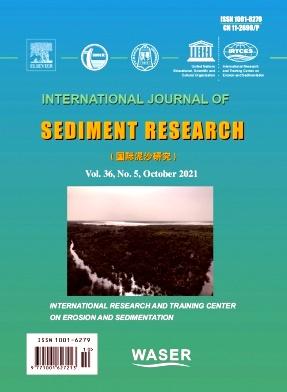Source distribution, ecological risks, and controlling factors of heavy metals in river sediments: Receptor model-based study in a transboundary river basin
IF 3.7
2区 环境科学与生态学
Q2 ENVIRONMENTAL SCIENCES
引用次数: 0
Abstract
In the context of transboundary rivers, which constitute intricate fluvial ecosystems, the persistent threat of heavy metals (HMs) contamination poses significant risks to ecosystem health. In this study, ecotoxicological hazards, governing factors, and the distribution of nine HMs (uranium (U), lead (Pb), cadmium (Cd), nickel (Ni), chromium (Cr), manganese (Mn), iron (Fe), zinc (Zn), and copper (Cu)), as well as sediment characteristics (sand, silt, clay, organic matter, and pH) are assessed within the sediment. The current investigation encompasses the analysis of twenty-seven sediment samples, utilizing inductively coupled plasma mass spectrometry, in the transboundary river basin of Bangladesh, specifically the Teesta River. Notably, the findings underscore the predominance of Cd as a contaminant, responsible for 51.85%, 81.84%, and 100% of the geo-accumulation index, contamination factor, and enrichment factor, respectively. The Teesta River emerges as moderately to highly polluted, with cumulative probabilities of 7.4%, 85.2%, and 7.4% denoting “medium”, “high”, and “priority” pollution levels, respectively. Regions in the upstream and downstream middle sections of the study area exhibit relatively higher pollution levels, particularly in proximity to Kaunia Upazila in the Rangpur district. Ecologically, the potential risk index indicates a low likelihood of ecological impacts at 77.8%, alongside a moderate risk observation of 22.2%. The current results attribute the distribution of these HMs to the pH and organic matter content within the sediment, serving as pivotal factors. To unravel the origins of the HMs, the positive matrix factorization (PMF) model successfully identifies four contributing factors, primarily from geogenic sources. Validation of the PMF model through Spearmen correlation and principal component analysis (PCA) reveals a consistent pattern, affirming its efficacy in this analysis. Within the region, HM sources are identified as originating from anthropogenic activities such as irrigation, industrial discharges, and domestic effluent, in addition to substantial inputs from geogenic sources. Recognizing the transboundary nature of metal pollution, the current study underscores the imperative for continuous and vigilant monitoring, coupled with the implementation of robust management practices. The interplay of both anthropogenic and geogenic factors necessitates a comprehensive approach to effectively and sustainably combat HM contamination.
河流沉积物中重金属的来源分布、生态风险及控制因素——基于受体模型的跨界河流流域研究
就构成复杂河流生态系统的跨界河流而言,重金属污染的持续威胁对生态系统健康构成重大风险。在本研究中,评估了9种重金属(铀(U)、铅(Pb)、镉(Cd)、镍(Ni)、铬(Cr)、锰(Mn)、铁(Fe)、锌(Zn)和铜(Cu))在沉积物中的生态毒理学危害、控制因素和沉积物特征(砂、粉、粘土、有机质和pH)。目前的调查包括利用电感耦合等离子体质谱法对孟加拉国跨界河流流域,特别是蒂斯塔河的27个沉积物样本进行分析。值得注意的是,研究结果强调了Cd作为污染物的优势,分别占地质累积指数、污染因子和富集因子的51.85%、81.84%和100%。Teesta河呈现中度至重度污染,累积概率分别为7.4%,85.2%和7.4%,分别表示“中度”,“高度”和“优先”污染水平。研究区中上游和下游区域的污染水平相对较高,特别是在Rangpur地区的Kaunia Upazila附近。在生态方面,潜在风险指数显示低生态影响的可能性为77.8%,中度风险观测值为22.2%。目前的结果将这些HMs的分布归因于沉积物中的pH和有机质含量,这是关键因素。为了揭示HMs的起源,正矩阵分解(PMF)模型成功地识别了四个主要来自地质来源的影响因素。通过spearman相关和主成分分析(PCA)对PMF模型进行了验证,发现了一致的模式,证实了PMF模型在本分析中的有效性。在该区域内,HM来源被确定为源自人为活动,如灌溉、工业排放和家庭污水,以及大量来自地质来源的输入。认识到金属污染的跨界性质,目前的研究强调必须进行持续和警惕的监测,同时实施强有力的管理做法。人为因素和地质因素的相互作用需要一个全面的方法来有效和可持续地对抗HM污染。
本文章由计算机程序翻译,如有差异,请以英文原文为准。
求助全文
约1分钟内获得全文
求助全文
来源期刊
CiteScore
6.90
自引率
5.60%
发文量
88
审稿时长
74 days
期刊介绍:
International Journal of Sediment Research, the Official Journal of The International Research and Training Center on Erosion and Sedimentation and The World Association for Sedimentation and Erosion Research, publishes scientific and technical papers on all aspects of erosion and sedimentation interpreted in its widest sense.
The subject matter is to include not only the mechanics of sediment transport and fluvial processes, but also what is related to geography, geomorphology, soil erosion, watershed management, sedimentology, environmental and ecological impacts of sedimentation, social and economical effects of sedimentation and its assessment, etc. Special attention is paid to engineering problems related to sedimentation and erosion.

 求助内容:
求助内容: 应助结果提醒方式:
应助结果提醒方式:


